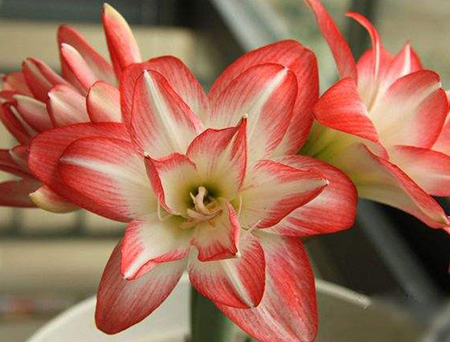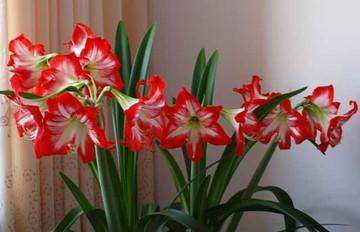Hippeastrum rutilum profile
Written by Maggie
Nov 13 2020

Hippeastrum rutilum is a perennial herb of the Amaryllidaceae Hippeastrum genus.
The bulb of hippeastrum rutilum is subglobose, with 6-8 leaves, extracted after flowering, bright green, the flower stem is hollow, slightly flat, with white powder; the perianth tube is green, cylindrical, the perianth lobes are oblong, the tip is pointed, magenta, slightly green with small scales on the throat.
Hippeastrum rutilum is distributed in Brazil and Hainan Province in Mainland China, and has been introduced and cultivated manually. European and American horticulturists specially produce Hippeastrum rutilum into canned flowers for the convenience of flower growers.
Hippeastrum rutilum picture

Morphological characteristics of Hippeastrum rutilum
The bulbs of Hippeastrum rutilum are nearly globose, 5-7.5 cm in diameter, and have creeping branches. There are 6-8 leaves, extracted after flowering, bright green, band-shaped, about 30 cm long, and about 2.5 cm wide at the base.
Hippeastrum rutilum flower stem is hollow, slightly flattened, about 40 cm high, about 2 cm wide, with white powder; flowers 2-4; budlike involucre lanceolate, about 3.5 cm long; stalk is slender, about 3.5 cm long Tepal tube green, cylindrical, about 2 cm long, perianth lobes oblong, pointed tip, about 12 cm long, 5 cm wide, magenta, slightly green, with small scales at the throat; stamens 6 , About 8 cm long, red filaments, anthers are linear-oblong, about 6 mm long and 3 mm wide; ovary is about 1.5 cm long, style is about 10 cm long, and stigma is 3-lobed. Flowering in summer.
Hippeastrum rutilum growth habit
Hippeastrum rutilum likes a warm and humid climate, and its growth temperature is 18~25℃. It does not like extreme heat and the sun should not be too strong. It should be kept under a greenhouse. Fear of waterlogging. During the dormant period in winter, a cold and humid climate is required, and the temperature should be 10-12°C, not lower than 5°C. Hi-rich sandy loam with good drainage. If the soil humidity is high in winter and the temperature exceeds 25℃, the stems and leaves will grow vigorously, hindering dormancy, and will directly affect the normal flowering the following year. Sunlight also has a certain effect on the growth and flowering of Hippeastrum rutilum. In summer, avoid direct exposure to strong light for a long time, and sufficient sunlight for winter cultivation. The soil requires loose, fertile sandy loam, with a pH of 5.5 to 6.5, and avoid standing water.
Hippeastrum rutilum geographical distribution
Hippeastrum rutilum is native to Brazil. In 1920, the United States bred precious pure white varieties. The Netherlands and Japan have also made great achievements in breeding. Hippeastrum rutilum has many horticultural varieties.
In addition, the Hippeastrum rutilum flower originating in the Peruvian Andes was introduced to Europe in 1769; the amaryllis originating from the Cape of Good Hope in South Africa was introduced to Europe in 1633. All over most provinces in China.

Hippeastrum rutilum reproduction method
Hippeastrum rutilum is commonly propagated by sowing, splitting and cutting.
Sowing method
Pick and broadcast, with high germination rate. The sowing soil is a mixture of 2 parts of peat soil and 1 part of river sand. The seeds are large and should be planted on demand. The spacing is 2 to 3 cm. The suitable temperature for germination is 15 to 20°C. Seedlings emerge in 10 to 15 days. The seedlings are divided into two true leaves. It takes 2 to 3 years from sowing to flowering.
Split ball
Old bulbs can produce 2 to 3 small balls per year, which can be removed and planted separately.
The artificial ball method is often used to propagate the child balls of Hippeastrum rutilum in large numbers, that is, the mother bulb is cut into several parts longitudinally, and then the middle part is divided into two halves, so that part of the bulb disc is attached to the lower end as the hair root part, and then the cutting is mixed with peat soil and sand In the cutting bed, properly watered, after 6 weeks, 1-2 small balls will appear between the scales, and roots will be formed in the lower part. Such a mother bulb can get nearly a hundred young bulbs.
Hippeastrum rutilum is easy to bear fruit, and artificial pollination is possible during the flowering period. The seeds mature after 2 months, and each capsule has about 100 seeds. Sowing immediately after harvest, with high germination rate. After sowing, place it in a semi-shade place, and keep it moist and at a temperature of 15 to 18°C, and it will germinate in half a month. If the temperature reaches 18-20℃, it will germinate after 10 days. Seed propagation takes 3 to 4 years to bloom. Sub-ball propagation takes place from March to April. The small balls around the cue ball are removed and planted. When planting, the top of the bulb should be exposed to the soil.
Cutting method
Cut the cue ball lengthwise of Hippeastrum rutilum into several pieces, then cut the scales, and insert them diagonally in vermiculite or sand. Plant when 2 true leaves grow. When planting fake bulbs, the potting soil is too relaxed, which will delay flowering or reduce the number of flowers. You can use a mixed soil of 5 parts of sandy loam, 2 parts of turf soil and 1 part of sand. The planting depth should be 1/3 of the bulb exposed to the soil surface.

Latest Updated
- Benefits of Bugleweed - 7 Science-backed Health Benefits
- Bugleweed Dangers & Side Effects - Is It Poisonous?
- How to Plant Evergreen Trees - What You Should Know
- When to Plant Evergreens - Grow Guide for Evergreen Trees
- 12 Wonderful Evergreen Shrubs for Your Garden
- 12 Popular Evergreen Plants with Pictures for Beginners
- When And How To Prune A Lilac Bush Like a Pro
- How to Grow & Care for Lilac Vine (Hardenbergia Violacea)
- Japanese Lilac Tree (Syringa Reticulata) Care & Propagation Guide
- Shumard Oak Pros and Cons - What to Know
Popular Articles
- Winter maintenance of Antirrhinum Majus
- How to Grow Terminalia Mantaly Tree
- How to Grow and Care for Crossostephium Chinense
- How to grow Antirrhinum Majus in spring
- Peristeria Elata (Dove Orchid) Profile: Info & Care Guide
- Underwatered Snake Plant (Sansevieria Trifasciata) - Signs And How To Fix
- How to Care for Brazilian Jasmine Plant (Mandevilla Sanderi)
- How to Grow & Care for Graptopetalum Purple Delight in Summer
- Rosa Chinensis (China Rose): Plant Growing & Care Tips
- How to Care for Baby Sun Rose (Aptenia Cordifolia)